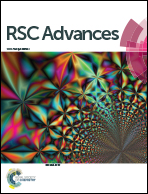Synthesis of silver–graphene nanocomposite and its catalytic application for the one-pot three-component coupling reaction and one-pot synthesis of 1,4-disubstituted 1,2,3-triazoles in water†
Abstract
A graphene based composite with silver nanoparticles has been synthesized via a simple chemical route and its catalytic activity has been tested for multi-component reactions and click reaction in a one-pot approach. This silver–graphene nanocomposite shows excellent catalytic activity at room temperature for three-component couplings between aldehydes, alkynes and amines (A3-coupling) and one-pot synthesis of 1,4-disubstituted 1,2,3-triazole via click reaction between in situ generated azides (derived from anilines or amines) and terminal acetylenes. This solid silver–graphene catalyst has been characterized by TEM, Raman, XRD and UV-Visible absorption spectra. The developed catalyst is air-stable, inexpensive, easy to prepare and can be facilely recovered and reused five times without significant decrease in activity and selectivity.


 Please wait while we load your content...
Please wait while we load your content...